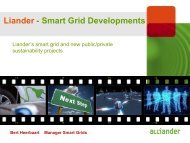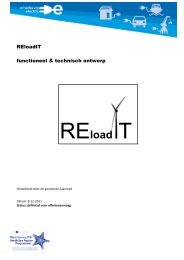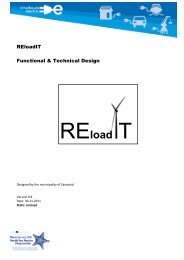renewable energy in zaanstad: from theory to practice - e-harbours
renewable energy in zaanstad: from theory to practice - e-harbours
renewable energy in zaanstad: from theory to practice - e-harbours
Create successful ePaper yourself
Turn your PDF publications into a flip-book with our unique Google optimized e-Paper software.
<strong>in</strong>vestments for re<strong>in</strong>forcements of the grid can be avoided. The Smart Grid technologies however<br />
requires <strong>in</strong>vestments <strong>to</strong>o, so a bus<strong>in</strong>ess case needs <strong>to</strong> developed and <strong>in</strong>vestigates. The concept of<br />
Smart Grid will be expla<strong>in</strong>ed <strong>in</strong> chapter 4.<br />
3.8 CONCLUSION<br />
The current <strong>energy</strong> demand of Zaanstad is 11.1 PJ per year and consists for a large part of natural gas<br />
(49%), transport fuels (28%) electricity (21%). As result of the MJA agreement and an <strong>in</strong>tensive<br />
collaboration with the built environment and <strong>in</strong>dustries, Zaanstad can reduce its demand <strong>to</strong> 9.1 PJ<br />
per year <strong>in</strong> 2020.<br />
Accord<strong>in</strong>g <strong>to</strong> Zaanstads <strong>energy</strong> policy, the <strong>energy</strong> consumption of Zaanstad needs <strong>to</strong> be generated <strong>in</strong><br />
a susta<strong>in</strong>able way with<strong>in</strong> its municipal boundaries by 2020. The available <strong>renewable</strong> <strong>energy</strong> sources<br />
<strong>to</strong> supply this demand are biomass, solar <strong>energy</strong>, w<strong>in</strong>d <strong>energy</strong> and geothermal <strong>energy</strong>.<br />
The electricity can be generated by biomass (CHP unit), PV cells and w<strong>in</strong>d turb<strong>in</strong>es. Biomass has a lot<br />
of potential <strong>in</strong> <strong>theory</strong> but <strong>in</strong> <strong>practice</strong> less, s<strong>in</strong>ce most of the biomass has already other dest<strong>in</strong>ations.<br />
In order <strong>to</strong> use this potential Zaanstad needs <strong>to</strong> negotiate with local companies. For solar and w<strong>in</strong>d<br />
<strong>energy</strong> Zaanstad has already made plans. Zaanstad plans <strong>to</strong> <strong>in</strong>stall 74 MWp of PV cells and 76 MW of<br />
w<strong>in</strong>d turb<strong>in</strong>es. This will be an electricity generation of 2.93 PJ per year. This is larger than the current<br />
electricity consumption. The electricity demand however is expected <strong>to</strong> <strong>in</strong>crease because of the<br />
ris<strong>in</strong>g population and the deployment of electric vehicles and heat pumps.<br />
The current heat demand is for the most part supplied by natural gas. In order <strong>to</strong> supply the heat<br />
demand <strong>in</strong> a susta<strong>in</strong>able way, Zaanstad can <strong>in</strong>vest <strong>in</strong> geothermal <strong>energy</strong>. Deep geothermal <strong>energy</strong><br />
can be used <strong>in</strong> the northern region; <strong>in</strong> the southern region an ATES of BTES system can be applied.<br />
This requires further research. The released heat <strong>from</strong> a biomass CHP plant can also be used, but as<br />
said this requires further negotiation with local companies.<br />
The changes <strong>in</strong> electricity and heat supply have consequences for the current <strong>energy</strong> <strong>in</strong>frastructure.<br />
A heat distribution network needs <strong>to</strong> be <strong>in</strong>stalled <strong>to</strong> support the local heat production. This way<br />
geothermal <strong>energy</strong> and biomass can be connected <strong>to</strong> this system. The <strong>in</strong>creas<strong>in</strong>g distributed<br />
generation by solar and w<strong>in</strong>d <strong>energy</strong> has possible consequences for the electricity distribution<br />
network. The impact of <strong>renewable</strong> distributed generation on the distribution network will be<br />
reviewed <strong>in</strong> the next chapter, <strong>to</strong>gether with the concept of Smart Grid.<br />
18









